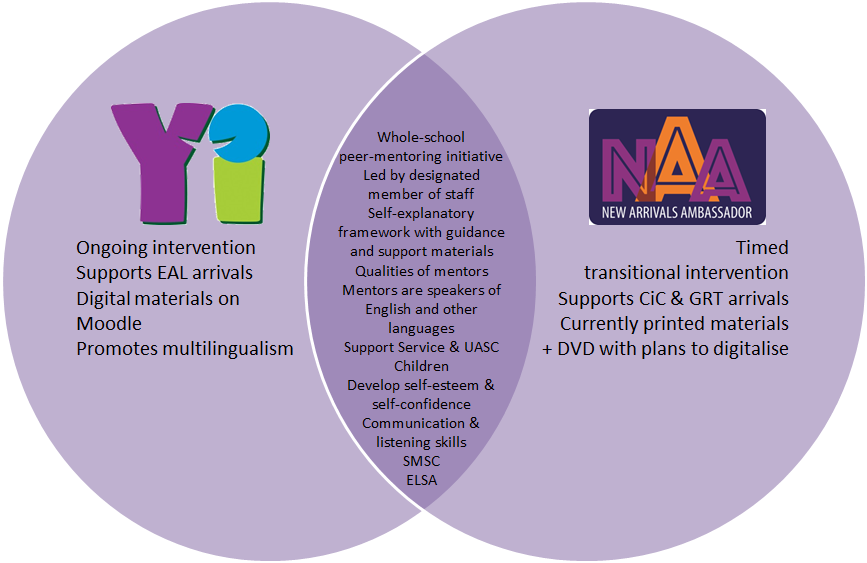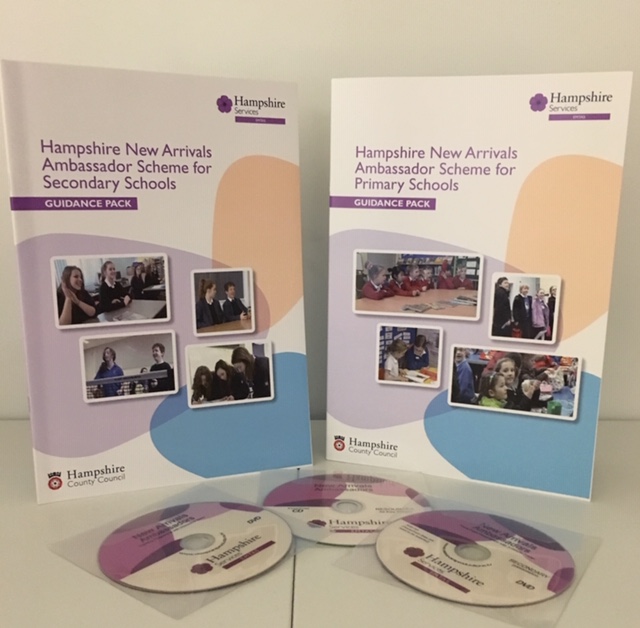Site blog
In a previous blog, Claire Barker and Astrid Dinneen discussed the benefits of setting up the New Arrival Ambassador and/or Young Interpreter Scheme for different groups of pupils. In this blog Louise Ret, Acting Principal Teacher at Gylemuir Primary School in Edinburgh, shares her experience of working with New Arrival Ambassadors to welcome a range of children joining school part-way through the year.
Gylemuir Primary is a non-denominational school located in Edinburgh. We have 570 pupils who come from a diverse range of faiths, cultures and countries. Over the past several years we have seen an increase in the number of pupils joining the school during the academic year, including pupils with English as an Additional Language. This is in large part due to the fact that our local community comprises many large banks and businesses that recruit staff from overseas, usually on a 2 year basis.
Moving
to a new school is challenging for any child, even if it’s five minutes away
from their current setting – but many of our families are also contending with
language barriers, an unfamiliar curriculum and a new job, often without the
support systems of family and friends. It became clear that we needed a way to
make families feel welcome and supported when they arrive at Gylemuir. We chose the New Arrival Ambassador
Scheme because the resource offers support to a range of pupils –
including non-EAL pupils who join our school at irregular times in the school
year.
The
New Arrival Ambassador scheme has been a fantastic resource for the school
because it offers a structured approach to training pupils in peer mentoring.
In 2018 the pupils went through an application and interview process to gain a
spot as an Ambassador and this year they have taken ownership of recruiting new
Ambassadors by creating their own application form and interview questions. We
had over fifty applicants from P5-P7, proving that the children see this as an
exciting and worthwhile role.
As
soon as a new pupil arrives at Gylemuir they are given a tour of the school by
our Ambassadors. At break and lunch time the Ambassadors find their new arrival
and buddy up with them to play games and explore the playground. They are
always on hand to offer support and guidance, and we all check in with each
other at weekly meetings to share how our new arrivals are getting on and offer
ideas on how to support each other. We are always looking at ways to improve
and expand the role of the Ambassadors – recently this involved working with a
group of teachers from Holland who were visiting our school!
Whilst the
scheme has helped pupils with English as Additional Language, it also provides
support to pupils who have moved from within Edinburgh. A new pupil recently
arrived from another school in the area and not only has she been helped
by the Ambassadors, she has now become an Ambassador! Having someone on hand to
welcome her allowed her to find her place in Gylemuir quickly and confidently.
Ultimately,
pupil wellbeing is at the centre of the scheme. Having an Ambassador buddy
means that pupils are nurtured, respected and included from the moment they
arrive at Gylemuir. For the Ambassadors themselves, the role offers an
opportunity to demonstrate their ability to be responsible and achieve success
in the wider school setting.
The
best part of the New Arrival Ambassador Scheme has been seeing how enthusiastic
the pupils are about their role. They take so much pride in sharing and
embodying our school values of Welcoming, Supportive, Creative and Happy and
encourage everyone in the school to do the same.
Louise Ret, Acting Principal Teacher at Gylemuir
Primary School
Twitter: @MissRet1 @gylemuirprimary
Visit the Hampshire EMTAS website to find out more and sign up to the New Arrival
Ambassador Scheme. Read this blog to learn more about the similarities and differences between the New
Arrival Ambassador Scheme and the Young Interpreter Scheme.
Subscribe to our Blog Digest (select EMTAS).
Several articles about the Young Interpreter (YI) Scheme and New Arrivals Ambassador (NAA) Scheme have already featured in the Hampshire EMTAS blog and many schools in Hampshire and across the UK are running either peer mentoring scheme - sometimes both - to support their new arrivals. Other schools have questions. Which scheme should we go for? Do they overlap? What difference is there? Our scheme managers Astrid Dinneen (YI) and Claire Barker (NAA) shed some light.

© Copyright Hampshire EMTAS 2019
Q: How did the schemes come about? Why did EMTAS decide to develop two separate schemes?
Astrid Dinneen: Back in 2004 we saw an increase of new EAL arrivals in schools after the accession of several countries to the EU. To support the well-being of these children, Hampshire EMTAS worked with school-based practitioners in four Hampshire schools to develop the Young Interpreter Scheme. The aim was to create a special role and train children/young people to become buddies and help new-to-English arrivals to feel welcome and settled. We are very proud to have won several awards since piloting the YI Scheme. Can you believe that the scheme is running in over 900 schools now?
Claire Barker: The New Arrivals Ambassador Scheme was borne out of a need by Children in Care, Traveller Children and Service Children to gain extra support when they arrived in schools at irregular times of the school year. Like the Young Interpreter Scheme, the aim was to support the well-being of these groups of children and to ensure they had a smooth transition into their new setting. The idea was to provide a short, sharp, peer mentoring programme lasting about half a term or in line with the needs of the newly arrived child. The scheme evolved after a successful piloting period that involved six schools covering all three phases.
Q: So each scheme is designed to support different groups of children, is it?
Astrid Dinneen: Yes. If your aim is to support EAL pupils whilst promoting the linguistic diversity of your school community then you may like to consider the Young Interpreter Scheme.
Claire Barker: And if your aim is to support all children joining your school at irregular times of the school year, including Children in Care, Traveller children and Service children, then you may like to consider the New Arrivals Ambassadors Scheme.
Astrid Dinneen: Of course some Service children and Children in Care (and particularly Unaccompanied Asylum Seeking Children) will also have English as an Additional Language so it's worth considering your school's needs carefully. Some schools are successfully running both schemes.
Q: How would running both schemes look?
Astrid Dinneen: An important feature of the YI and NAA schemes is that each is delivered by a designated member of school staff. In schools where both schemes are running it’s a good idea for each to be led by different people who can cater for their own scheme’s specificities and also collaborate on joint work. For example, the Young Interpreter Co-ordinator will buddy up Young Interpreters with new EAL arrivals. When a new EAL arrival also happens to be a Service child, then Young Interpreters can work alongside New Arrival Ambassadors to show them the ropes.
Another important aspect of running the Young Interpreter Scheme is that the Co-ordinator regularly meets with the Young Interpreters to guide them and keep them motivated in their role. This follow up phase could be another opportunity for joint work and there are suggested activities on the YI’s Moodle. For example, why not work together to promote both NAA and YI roles by creating a movie trailer?
In terms of pupil selection I think the qualities you would look for in Young Interpreters are similar to those you would expect from a New Arrival Ambassador. Pupils should be friendly, empathetic, welcoming and good communicators. Young Interpreters can be speakers of English only and they can be speakers of other languages too. The same could be said of the NAA, couldn’t it?
Claire Barker: It certainly could and the schemes complement each other when both are running in the same school setting. It is worth remembering that the NAA Scheme is a timed transitional intervention whereas the YI Scheme is ongoing with its support. The aim of the NAA is to develop the self-esteem and self-confidence of the newly arrived child so they are able to function independently after half a term.
I agree with Astrid that the two schemes work better when managed by different people in the school so the lines of what each scheme has to offer do not become blurred. Whilst the skills and qualities of a Young Interpreter and an Ambassador are virtually the same, the job description is very different and each has its own demands and specialist areas for the trained pupils. NAA pupils have to learn to build relationships and trust quickly as their support is delivered over a short period of time. Schools do utilise the trained Ambassadors in different ways throughout the year. Some schools use the Ambassadors to support the new intake in September and to work with classes and tutor groups throughout the academic year. Many schools use the Ambassadors alongside their School Council to represent the school on Open events like Parents’ Evenings. Some schools use their Ambassadors to support existing pupils who are struggling with their well-being and life at school. The scheme has flexibility to be adapted to the setting it is being used in.
Both schemes complement each other and pupils who are Young Interpreters and Ambassadors are highly skilled and proficient peer mentors who can offer linguistic support, well-being support and transition support. Both schemes develop self-esteem and confidence in the Young Interpreters and Ambassadors as well as in the pupils they are supporting and provide opportunities for personal growth.
Q: Where can our readers find out more?
Astrid Dinneen: You can learn more about the Young Interpreters on our website, follow us on Twitter or Facebook or read the December issue of the Young Interpreters Newsletter.
Claire Barker: There is information about the NAA on our website. You can also use the tabs below to read other blogs relating to both schemes.
By Laura Harman-Box, Year 6 teacher with responsibility for the New Arrival Ambassadors (NAA) at Talavera Junior School with an introduction from EMTAS Specialist Teacher Advisor Claire Barker.

Recently I had the pleasure of working in Talavera Junior School in Aldershot. I went to train thirteen young people to be New Arrival Ambassadors (NAA). Talavera Junior School is a very diverse school that welcomes children from many counties, cultures and religions. Many of their children are from Service families and this is one of the groups than New Arrivals Ambassadors works particularly well with. Many Service children are used to transition in their lives and are able to talk confidently about what makes a good transition for them. The children who have experienced transition all say how they wished they had had a New Arrivals Ambassador when they went to their new school. It highlights to the whole cohort that is being trained that everyone - adults and children - experience the same fears and insecurities when faced with a new challenge and setting. Laura Harman-Box, Year 6 teacher at Talavera with responsibility for NAA had this to say after the training:
The New Arrival Ambassador Scheme seemed like a perfect fit for our school, working both as a welcoming system for our high level of new entrants and as a chance to develop leadership qualities in our pupils.
As a school in a garrison town, our school population can be very turbulent. This is, understandably, difficult for some pupils, particularly when they find it hard to then find their place in their new environment. We believe that we offer great support for pupils who enter at an unusual time of the year but are also aware that some pupils will need additional transitional support. Who better to deliver this than the peers with whom our new arrivals will be learning, playing and growing?
We chose our New Arrival Ambassadors based on the emotional literacy level of the children and children who would themselves benefit from taking on a role of responsibility within our school. The training itself was such a positive experience, in part because of the diverse range of children (ethnically, culturally, age-wise, academically, with regards to interests) who could bring an eye-opening number of experiences to this scheme. Encouraging and providing opportunities for all pupils is a fundamental value of our school, especially leadership roles. The NAA Scheme has provided us the chance to give this opportunity to children who may not otherwise always get it.
Our pupils' well-being is a continued focus for us and the
NAA scheme provides another valuable way of ensuring all pupils feel safe,
comfortable and ready to learn. This is the start of a journey for our New
Arrivals Ambassadors, one that they cannot wait to begin! Here are their comments:
Today we learnt about becoming a New Arrival Ambassador and how we can help new arrivals with settling in their new class without making them panic. We learnt today that new arrivals can choose who they want to be friends with, which surprised some of us. We thought it would be our job to be their friend but our trainer, Claire, helped us to understand that everyone should choose their own friends. We were taught that if a new arrival tells us something and it is serious, we must tell the teacher immediately due to the fact that we can't always help them. We've learnt that a New Arrival Ambassador is a very important job and we must work hard to continue to represent our school and make every new pupil feel comfortable and safe here. We look forward to being New Arrival Ambassadors!
Visit the Hampshire EMTAS website to find out more about the NAA and come back soon to read a blog comparing the NAA with the Young Interpreter Scheme.

